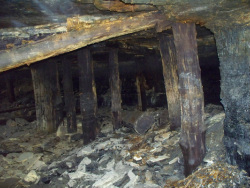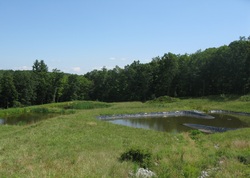Abandoned Mine Drainage

Abandoned mine drainage (AMD) is the legacy of historic coal mining that was conducted with little to no regulation prior to enactment of the federal Surface Mining and Control Reclamation Act in 1977. As coal was extracted from the earth, the mining activities exposed naturally occurring elements such as pyrite. The weathering of pyrite creates highly acidic water that then leaches metals such as aluminum, iron, and manganese from the surrounding soils and rocks. The resulting polluted water, or AMD, is often so toxic that no aquatic life can survive in it.
Beginning two miles downstream of the Alvin R. Bush Dam, over six miles of Kettle Creek and many more miles of tributaries are essentially lifeless due to pollution from acid mine drainage (AMD). High acidity, low pH, and high concentrations of metals such as aluminum and iron are some characteristics of AMD that prevent most aquatic organisms from living in these waters. The Lower Kettle Creek Restoration Plan, developed by private consultants for the KCWA, outlines strategies and recommends treatment alternatives for AMD remediation in the lower watershed.
Beginning two miles downstream of the Alvin R. Bush Dam, over six miles of Kettle Creek and many more miles of tributaries are essentially lifeless due to pollution from acid mine drainage (AMD). High acidity, low pH, and high concentrations of metals such as aluminum and iron are some characteristics of AMD that prevent most aquatic organisms from living in these waters. The Lower Kettle Creek Restoration Plan, developed by private consultants for the KCWA, outlines strategies and recommends treatment alternatives for AMD remediation in the lower watershed.

In 1998, the KCWA along with Trout Unlimited through its Kettle Creek Home Rivers Initiative began working on solutions to abate the AMD pollution and restore the lower Kettle Creek watershed. Between 1998 and 2013, four passive treatment systems and a land reclamation project were completed, as well as multiple collection systems and numerous AMD assessments and remediation plans. To learn more about these projects, read these project summaries.
This work has begun the process of restoring the lower section of Kettle Creek and Twomile Run. The most striking example of how well these efforts are improving water quality is seen below the Middle Branch Treatment system. This system was rehabilitated in 2007 and just one year later aquatic insects were found below the system. In 2010, Trout Unlimited documented brook trout below the system, and just two years later found young-of-the year brook trout. This indicates that not only are brook trout now able to live in this stream from its headwaters to mouth, but are also reproducing in the entire length of the stream.
In 2014, a fish survey by TU biologists confirmed that brook trout had returned to the previously dead, AMD-polluted Twomile Run. Approximately 40 brook trout were captured with many young-of-the-year and several size classes represented all the way up to about 8 inches. Brook trout now inhabiting and reproducing in a large portion of the watershed. With the completion of a large land reclamation project and time, these fish will hopefully be swimming all the way to the main stem of Kettle Creek!
The KCWA continues its partnership with Trout Unlimited and together they continue to implement AMD remediation projects with the ultimate goal of restoring the lower Kettle Creek watershed. Through these partnerships and the continued work of dedicated volunteers and professionals it is expected that brook trout will be found at the mouth of Twomile run in the near future. The restoration of lower Kettle Creek may take long, hard work — but the results will be enduring.
This work has begun the process of restoring the lower section of Kettle Creek and Twomile Run. The most striking example of how well these efforts are improving water quality is seen below the Middle Branch Treatment system. This system was rehabilitated in 2007 and just one year later aquatic insects were found below the system. In 2010, Trout Unlimited documented brook trout below the system, and just two years later found young-of-the year brook trout. This indicates that not only are brook trout now able to live in this stream from its headwaters to mouth, but are also reproducing in the entire length of the stream.
In 2014, a fish survey by TU biologists confirmed that brook trout had returned to the previously dead, AMD-polluted Twomile Run. Approximately 40 brook trout were captured with many young-of-the-year and several size classes represented all the way up to about 8 inches. Brook trout now inhabiting and reproducing in a large portion of the watershed. With the completion of a large land reclamation project and time, these fish will hopefully be swimming all the way to the main stem of Kettle Creek!
The KCWA continues its partnership with Trout Unlimited and together they continue to implement AMD remediation projects with the ultimate goal of restoring the lower Kettle Creek watershed. Through these partnerships and the continued work of dedicated volunteers and professionals it is expected that brook trout will be found at the mouth of Twomile run in the near future. The restoration of lower Kettle Creek may take long, hard work — but the results will be enduring.
Reports
Monitoring Biological Recovery in the Twomile Run Watershed Following Abandoned Mine Drainage Remediation (2013) DOWNLOAD PDF (2.24 MB)
Twomile Run Water Quality Monitoring (2013) DOWNLOAD PDF (335 KB)
Swamp Area Passive Treatment System: Technical Report (2013) DOWNLOAD PDF (79 KB)
KC204 Mine Pool Stabilization Project (2011) DOWNLOAD PDF (7.9 MB)
Reassessment of Acid Mine Drainage Pollution in the Twomile Run Watershed DOWNLOAD PDF (2.5 MB)
West Side of Lower Kettle Creek AMD Remediation Master Plan (2007) DOWNLOAD PDF (345 KB)
Middle Branch Passive Treatment System Rehabilitation Projects: Technical Report (2007) DOWNLOAD PDF (145 KB)
Twomile Run Watershed AMD Remediation Master Plan (2007) DOWNLOAD PDF (600 KB)
Huling Branch Mine Complex: Investigation of Acid Mine Drainage and Recommendations for Remediation (2004) DOWNLOAD PDF (243 KB)
Lower Kettle Creek Restoration Plan (2000) DOWNLOAD PDF (2.5 MB)
Twomile Run Water Quality Monitoring (2013) DOWNLOAD PDF (335 KB)
Swamp Area Passive Treatment System: Technical Report (2013) DOWNLOAD PDF (79 KB)
KC204 Mine Pool Stabilization Project (2011) DOWNLOAD PDF (7.9 MB)
Reassessment of Acid Mine Drainage Pollution in the Twomile Run Watershed DOWNLOAD PDF (2.5 MB)
West Side of Lower Kettle Creek AMD Remediation Master Plan (2007) DOWNLOAD PDF (345 KB)
Middle Branch Passive Treatment System Rehabilitation Projects: Technical Report (2007) DOWNLOAD PDF (145 KB)
Twomile Run Watershed AMD Remediation Master Plan (2007) DOWNLOAD PDF (600 KB)
Huling Branch Mine Complex: Investigation of Acid Mine Drainage and Recommendations for Remediation (2004) DOWNLOAD PDF (243 KB)
Lower Kettle Creek Restoration Plan (2000) DOWNLOAD PDF (2.5 MB)
